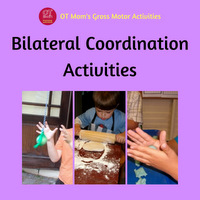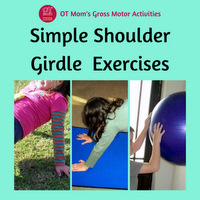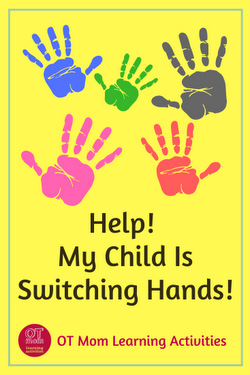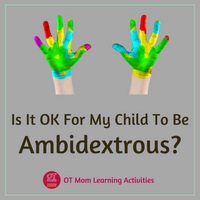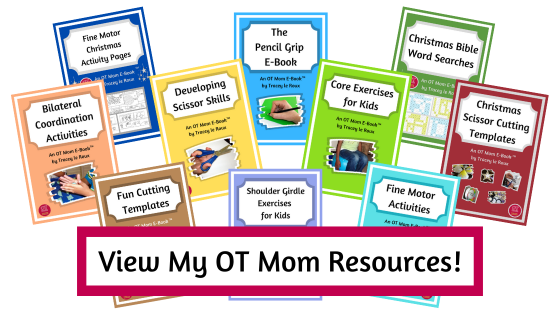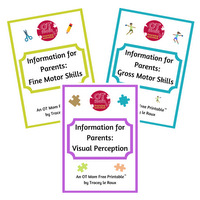- Home Page
- Hand Dominance
- Switching Hands
Is Your Child Switching Hands?
Switching hands is often seen in young children, who may often swap hands while painting, coloring, or eating with a fork/spoon.
It is not usually a concern when a toddler or young child swaps hands, as they are still learning how to use their hands well together, and trying out what feels right for them.
I sometimes link to products (#Ad) that are similar to those I use and love. If you do purchase something through my links, I will receive a small commission that helps support my site - thank you!
However, if your child is still switching hands when entering formal schooling, this may affect important school skills, such as cutting out with scissors and developing handwriting skills.
In order for your child to do well at learning to write, there has to be a dominant, strong hand that becomes specialized at doing the job of controlling the pencil.

This page looks at some practical ways that parents can help their child develop a strong, specialized hand for handwriting. (Background information and research are covered in my related pages.)
These suggestions are intended to encourage your child's normal handedness development.
If you suspect your child has hand dominance delays, please seek a professional opinion.
Here are some questions to consider when your child swaps hands:
- Are your child’s bilateral coordination skills poor?
- Does your child usually begin fine motor tasks with the same hand, and then swap hands when feeling tired?
- Does
your child use the left hand when things are presented on the left side
and the right hand when things are presented on the right side?
- Does your child seem to pick a hand at random and swap at random?
- Related pages (containing additional information and research on hand dominance)
1) Are your child’s bilateral coordination skills poor?
Learning to use both hands together in a coordinated way is actually an important first step in developing a specialized, or dominant, hand.
There are three different aspects to bilateral coordination.
Your child needs to be able to:
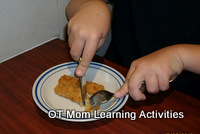 Using both hands in a coordinated way
Using both hands in a coordinated way- use both hands together at the same time (symmetrical movements),
- use both hands together in an alternating way (reciprocal movements)
- use one hand as an assistant to a “specialist” hand in an activity (such as drawing a line with a ruler, spreading butter on bread).
Remember, as well as wanting a strong, dominant hand to emerge, we also want the “other” hand to become a good “assistant”.
When your child has not yet established a specialized hand and an assistant hand, you may find that your child is switching hands during activities or between activities.
Try these free bilateral coordination activities to help your child develop this important skill.
2) Does your child usually begin fine motor tasks with the same hand, and then switch hands when feeling tired?
Children who have weak hand muscles, or poor fine motor skills, often get tired and swap hands during fine motor activities.
If your child often shakes out a tired hand, complains about an activity taking too long, and swaps between hands during an activity to give each hand a break, then he/she may need some help with fine motor skills.
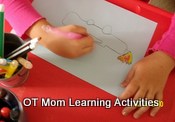 Poor fine motor skills can make your child's hands tired
Poor fine motor skills can make your child's hands tiredYou can help your child strengthen their dominant hand with lots of scissor cutting activities, and hand strengthening exercises.
Activities such as such as playdough, paper crumpling, playing with lego etc. can give both hands a chance to get stronger.
If your child does not yet start with the same hand regularly, and you are unsure of which hand is actually the preferred hand, then encourage fine motor activities that use both hands equally.
Always present activities in the center of your child’s body (midline) so he/she can reach for them with either hand.
Working on shoulder girdle stability and core muscles may also help to improve your child’s overall endurance of fine motor activities.
For convenience, try my Fine Motor E-book packed full of easy fine motor activities to do at home!
3) Does your child use the left hand when things are presented on the left side and the right hand when things are presented on the right side?
If this is the case, then there may be some delays in crossing the midline.
If your child avoids crossing the midline, you may notice that the left hand gets used when the tools are given on the left side of the body, and the right hand when the tools are given on the right side of the body.
 Picking up cards on the left with the left hand
Picking up cards on the left with the left handIf your child is doing this, then both hands will tend to get equal practice at developing skills, and your child’s true handedness may be apparently delayed.
Always try and put pencil, paper, scissors in the center in front of your child to see which hand is naturally used.
Try some fun activities for crossing the midline to help your child develop midline crossing skills.
4) Does your child seem to be switching hands at random?
Switching hands is common in young children, but children who are about to enter formal schooling need to be working on establishing a preferred hand.
If you and/or your child’s teacher are concerned about your child’s switching hands, and it is interfering with the development of skills that they need for school and self care, then please make an appointment with a pediatric occupational therapist.
Please never choose a hand for your child. This can have horrible long term consequences, and I speak from experience from working with children who were forced into a specific handedness.
An occupational therapist can help to get to the bottom of your child’s particular difficulties (remember, every child is different!) and will develop a treatment routine specifically for your child.
One mom wrote to me to say that she made a rule that her child had to finish a task with the hand she started with. Apparently, her daughter soon figured out which hand was her "best" hand and began completing her tasks with that hand. That route may be worth a try if there seems to be no underlying reason for your child switching hands.
Related Pages On My Site
These pages contain additional information as well as recent research around this topic.
I hope you found this article helpful! Why not sign up for my occasional, free newsletter to keep in touch with new and updated pages on my site?
- Home Page
- Hand Dominance
- Switching Hands
Share this page to help others!
Didn't find what you were looking for? Try a search of my site!
